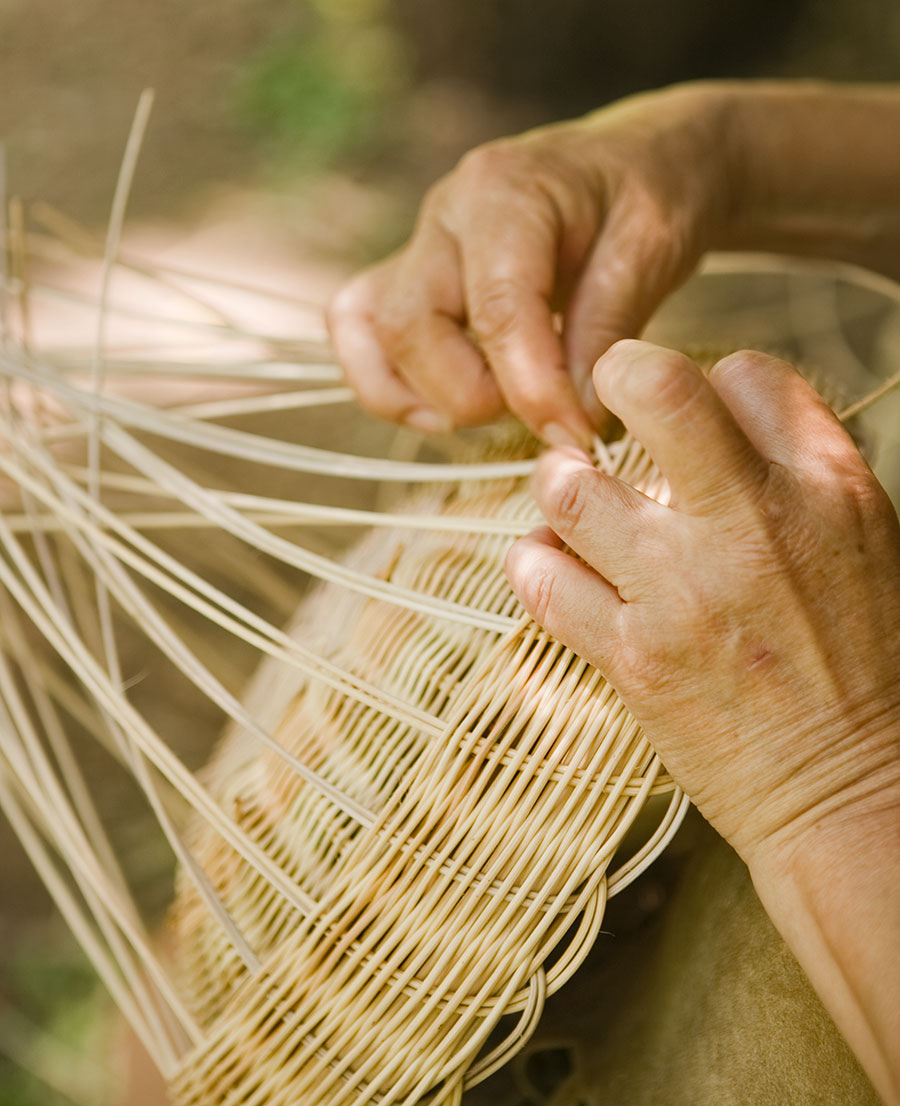
1. Iva Rattler | 2. Lois Calonehuskie | 3. Onita Bush | 4. Bessie Jumper | 5. Edna Chekelelee | 6. Zena Rattler | 7. Storytelling Group | 8. Emma Garrett | 9. Martha Wachacha | 10. Callie Wachacha | 11. Haylee Garland | 12. Ella Bird | 13. Shirley Oswalt | 14. Maggie Wachacha
Snowbird Matriarch Mural
In 2015, Michelle Shiplett, Doreyl Ammons and TJ Holland sat down and had an idea to highlight the Snowbird Cherokee community in a way that Robbinsville has never seen. The Snowbird community is 50 miles southwest of the main Cherokee reservation and is off the path from the regular tourist route. The Snowbird Cherokee people have been able to maintain high levels of traditionalism because of this distance factor. Graham county has scattered reservations lands throughout, this is unlike the larger reservation in Cherokee that is made up of a large tract of land. With this there are sprinkles of rich Cherokee culture that don’t always get the same recognition that the main reservation has. The GREAT foundation wanted this to change. When they were able to secure a Z. Smith Reynolds Foundation grant on the main street of Robbinsville, they found that the most renowned people of the Snowbird community should get the spotlight; the matriarchs that have held the community together.

Our Story
The Snowbird Cherokee’s Community is unique as they reside on over 2,200 acres scattered lands throughout Graham County, North Carolina. Many of the Snowbird Cherokee are descendants from those who resisted the removal infamously known as the Trail of Tears. These Cherokee took to the steep mountains of the Nantahala to avoid removal west. The story of the Snowbird Cherokee differs from those of the Qualla Town Cherokee. Both Eastern Cherokee communities share the same status of remaining in the Cherokee homeland, though they were led by different prominent Cherokee leaders with different views of the colonizing world in the 19th century. Many of the Snowbird Cherokee did not want to adapt to the changing ways of the world and wanted to continue to live traditionally Cherokee, and many did. As the Snowbird community was isolated from local towns, those who wanted to continue to live how their ancestors did for thousands of years before were left alone to do so. Many of the tribe’s full-blood members reside here today and are proud to be Snowbird Cherokee.
Cherokee society traditionally ran off a matrilineal clan system. This meant that when children were born that they would associate themselves with the mother’s family or clan before the father’s family or clanship. The matrilineal ties are still strong here in Snowbird and the respect for the matriarch in each family remains high. TJ Holland, a liaison for the Eastern Band of Cherokee Indians who specialized in the Snowbird community, advised Michelle Shiplett to use the communities’ women on this mural project. They sat down together and went through the communities beloved women. Being that all the women here possess the qualities of titled beloved women, they couldn’t exclude the many beloved women that the Snowbird community recognized. From creating initiatives to save the language to birthing babies, these women have done it all while raising their own families and sharing ancestral knowledge with future generations. With help from local Cherokee artists, this colorful project brought many of these women’s legacies to life.

Iva Rowena Rattler
Iva Rattler spent her life working to preserve and protect Cherokee culture, while also sharing her knowledge with many. Iva wrote a book called, “How to Make Soap”, where she explains her process in great detail. Iva was the founder of Fading Voices committee, an annual demonstration event in Snowbird. She would demonstrate her soap (ᎣᎳ – ohla) making process and would also bring turtle shells (ᏓᎦᏏ ᏧᏯᏍᎦ – dagsi tsuyasga) for those who brought dirt to the mound building ceremony during the Fading Voices event. Iva was married to Willie Rattler, who she speaks about in her soap book; they had 4 sons together. Like many of these women, Iva was a first language Cherokee speaker. This meant they did not encounter the English language until it was enforced at the Snowbird Day School. She was also a homemaker, and medicinal plant expert, all while giving her time as a volunteer to the Snowbird Community.
Iva Rattler in Cherokee
Iva Rattler in English
Eunice Lois Rattler Calonehuskie
Eunice Lois Rattler Calonehuskie lived her entire life in the Snowbird community. She was an inspiration and a gem to the Snowbird people. Her grandfather was Armstrong Cornsilk, who was a prominent Cherokee preacher and a veteran of the Civil War, so it is of no surprise, she had the strength and purpose of a warrior. Lois attended the boarding school in Cherokee where she was a student of Lottie Stamper, the celebrated basket maker. In 1950, she married Simon Calonehuskie and together they raised five children. Both Lois and Simon were fluent speakers in the Cherokee language. She worked in education as a teacher (ᏗᏕᏲᎲᏍᎩ – dideyohvsgi), in many different capacities, ranging from Head Start supervisor to instructor for community college level classes. In 1986, Lois was selected as the project director for Fading Voices. This was an oral history project, which was funded for one year, from the North Carolina Arts Council. The compilation of interviews, by Snowbird Cherokee elders, was later published in the Journal for Cherokee Studies (Volume XIV 1991). The following year Fading Voices Demonstration Day, a celebration of Cherokee culture began. Lois’ leadership helped establish Fading Voices as an ongoing yearly celebration which continues to this day.I felt this quote best describes my mother’s (ᎤᏥ – utsi) mission to preserve our history, “This needs to be captured now before all our history fades away. When I was growing up, I was not aware of the history of the tribe. It was not taught in the schools and very few people talked about it. We hope this will help our children learn about what it means to be Cherokee.” (Lois Calonehuskie, Atlanta Journal and Constitution, May 24, 1987).
Lois Calonehuskie in Cherokee
Lois Calonehuskie in English
Onita Bush
Onita Bush has made it her life’s work to help the Snowbird (ᏚᏘᏱ – tutiyi) community, giving countless hours to community initiatives to preserve Cherokee culture. Onita worked as a home health nurse with the tribe for 16 years before happily retiring in 2019. Onita has received many honors throughout her career including the Community Treasure Award presented to her by One Dozen Who Care Inc. She is a board member for the Center of Native Health and often speaks regularly at different universities such as Western Carolina University sharing the importance of plant medicine.
Onita Bush in Cherokee
Onita Bush in English
Bessie Smoker Jumper
A little Snowbird woman, Bessie Jumper, was loved by many, especially her family. She was a white oak basket maker, hard stitch quilt maker, and known famous for her hominy (ᎧᏃᎮᎾ – kanohena). She was married to Henry Jumper, they had 5 children and 2 foster children. Bessie had no formal training on how to make baskets or quilts but learned by watching her mother. She would walk with her mother back and forth across the mountain to Andrews where they would sell and exchange their baskets for food and household items. She provided for her family selling crafts and carrying on all the knowledge her mother had shared with her.
Bessie Jumper in Cherokee
Bessie Jumper in English
Edna Marie Wachacha Chekelelee
Edna Chekelelee promoted Cherokee traditions in her community through dance, storytelling, and crafts. She was a godly woman who kept her Cherokee traditions evenly balanced in her heart. Edna had no children of her own but her and her husband Boyd adopted 3 children and had 5 foster children. In traditional Cherokee culture, there are no orphans due to the matrilinear clan system in place. A Cherokee child is never without family (ᎤᏩᎳᏘᎾᎢ – uwalatinai). Edna traveled all over the country spreading Cherokee culture and reminding others of our presence in America. She shared her love for her culture with non-natives across the nation. She toured with the original Snowbird Ant (ᏙᏒᏓᎵ – dosvdali) Dancers and various gospel singing groups. She taught Cherokee arts and crafts like basket making, beadwork, doll making and quilt making at Robbinsville High School. Edna was known for her humility in breaking down stereotypes surrounding modern Cherokee life and carrying on traditions through her teaching.
Edna Chekelelee in Cherokee
Edna Chekelelee in English
Temotzena (Zena) Long Rattler
Zena Long Rattler was the first council woman for the Snowbird/Cherokee County communities, serving 2 terms. She was married to Ammons Rattler; they had a large family of 8 children. Zena worked for the Snowbird Day School as a cook. She often taught home economics, where she would teach the students how to can and preserve foods using the vegetables grown in the Day School Garden. Zena was active in the original Snowbird Indian Quartet traveling all over Tennessee, Georgia and North Carolina. Zena was very well respected and loved by many (especially her students) and her church family. Read more about the Snowbird Day School: (87) (PDF) Stories of the Snowbird Day School | Trey Adcock – Academia.edu
Zena Rattler in Cherokee
Zena Rattler in English
Emma Jackson Garrett
Emma Garrett was an outstanding basket maker; her works are displayed in museums from Washington to Atlanta. Emma traveled the nation to share her art of basket weaving with people from all walks of life. She often taught classes and demonstrated her skills in rivercane basketry at various Native American festivals. Many say that rivercane is one of the most challenging materials to weave with. Along with her successes in basketry, she was a loving wife (ᎤᏓᎵ – udali) to James Garrett and the mother of 2 children. She sung in the Snowbird (ᏚᏘᏱ – tutiyi) Quartet and was a member of the Qualla Arts and Crafts Mutual. Those who knew Emma say that she was a selfless woman who would do anything for someone she felt was in need.
Emma Garrett in Cherokee
Emma Garrett in English
Martha Welch Wachacha
Martha Welch Wachacha was just sixteen when she met and married John Wayne Wachacha at the Cherokee fair, what’s now known as the annual fall festival. After their marriage, they moved to John Wayne’s home in West Buffalo, where they raised 12 children together. Martha was very active in the community. She was an excellent white oak basket maker, did bead work, and cooked all the traditional Cherokee foods. She and John Wayne were also very involved in Church. Martha loved to sing (ᏧᏃᎩᏍᏗ) gospel songs in the Cherokee language, as she was the note singer. Martha was known as a giving person, who would give away almost anything she had to someone who needed it.
Martha Wachacha in Cherokee
Martha Wachacha in English
Callie Hornbuckle Wachacha
Callie Hornbuckle Wachacha grew up in Cherokee, North Carolina where she attended the Cherokee Boarding School as a child. Callie married Moses Wachacha, they had 7 children together and raised them here in Snowbird. Callie was very involved in community events, serving on the election board and various others. She was also a known storyteller (ᎧᏃᎮᏍᎩ – kanohesgi) in the community. When she started her sentence out with “long years ago”, you knew you were about to hear a story come from her. Her work was raising her children (ᏕᏥᏯᏛᎯᏍᏗᎲᎩ ᏧᏪᏥ – detsiyadvhisdihvgi tsuwetsi) and being the best homemaker, she could. The Snowbird community recognizes her for her role in being a homemaker, one of the most important roles of the matriarch.
Callie Wachacha in Cherokee
Callie Wachacha in English
Ella Bird
Ella Bird was given one of the few Eastern Band of Cherokee Indian’s titles of Beloved Woman in 2013. Her dedication to her family, culture and language is inspirational to many. Ella was born in the mountains of West Buffalo (ᏭᏕᎵᎬᎢ ᏯᎾᏐᎯ – wudeligvi yanasohi) where she would spend the rest of her life raising her 10 children with her husband, William Bird. All her children were taught the Cherokee language and continue making traditional Cherokee crafts today. Ella is well known for her hand stitched quilts, one of her blanket designs is painted on the mural panel dedicated to her. Mrs. Bird has received numerous awards for dedication to the Cherokee way of life. She received an honorary doctorate degree from the University of North Carolina Asheville in 2017, where she also has a building dedicated to her. To read more about Ella click here: The right path: Beloved Woman Ella Bird reflects on life marked by family, tradition (smokymountainnews.com)
Ella Bird in Cherokee
Ella Bird in English
Shirley Oswalt
Shirley Oswalt was named Beloved Woman (ᎠᏥᎸᏉᏗ ᎠᎨᏯ – atsilvgwodi ageya) for her contributions to educating our children and community with her knowledge of cultural traditions and our language. Our language will survive in part because of her commitment to teaching and her love for our people. Shirley was also an accomplished artist whose work has enriched the lives of many people beyond our community. She made pottery, beadwork, and painted gourds. As Beloved Woman, Shirley provided guidance for tribal leaders, teachers, and her community. She had 3 children and a loving husband Wendall Mack Oswalt. Her dedication to the preservation of our language and culture will ensure that generations to come will continue to know and share traditional craft making and language preservation.
Shirley Oswalt in Cherokee
Shirley Oswalt in English
Maggie Axe Walkingstick Wachacha
Maggie Wachacha was one of the first (ᎠᎬᏱ – agvyi) Cherokee Beloved Woman in more than 200 years for the Eastern Band. She was chosen for this title due to her commitment to tribal affairs, her knowledge of medicine, and her work to preserve the Cherokee language. Maggie never fully learned to speak English. Maggie worked as the tribal clerk for over 40 years, recording the meeting’s minutes in her native language. Her late husband, Jarrett Wachacha, was a council member for several years. Before motor vehicles, they would walk 60 miles from Snowbird to Cherokee to attend council sessions, which would occur once to twice a year for a weeklong gathering. Maggie was a known midwife (ᎠᏓᎦᏘᏗᏍᎩ – adagatidisgi) in Snowbird and delivered over 3,000 babies during her lifetime, while having 3 children of her own. She was named one of 100 American heroes by Newsweek and was honored with the Distinguished Women of North Carolina Award as well.

